Round sink: materials, installation methods
Of course, the oval or round sink on the countertop for the bathroom is always beautiful, but it's not so simple, because the bowl can be made of completely different materials. In addition, the methods of installation for the final result can also be radically different from each other.
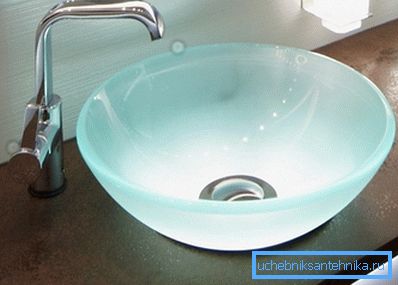
So, you can find commercially available containers from:
- porcelain,
- faience,
- marble,
- glass,
- ceramic granite (composite),
- become.
And according to the type of installation, these products can be overhead or mortise (recessed) bowl. Below we will tell you a little more about the materials themselves and how to install the tanks, and you can also study the informative video in this article on this topic.
Bathroom Sinks
Materials
Note. Technical characteristics, design of sinks, and also their price, directly depend on material of production. But the principle is the more expensive - the stronger is not valid here, so the cheapest bowl of steel is the most durable mechanically.

- Of course, porcelain, as a material, is known to everyone, but not everyone knows that it can be hidden under the word ceramics, so the ceramic sink can be either faience or porcelain.
- But the latter material has an extremely dense structure, which makes the surface of products practically invulnerable to porous pollution, the bowl can be washed with abrasive detergents and it is not afraid of high temperature.. Except for sudden changes. But such a capacity is afraid of impacts (fragile) and its cost is quite high.
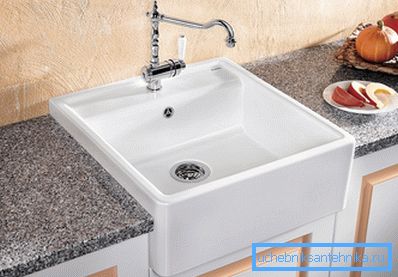
- Visually, faience hardly differs from porcelain, and it will be extremely difficult or even impossible for an inexperienced person to determine the material - the surface seems absolutely identical.
- But this is only visually, for example, the round glass sink that you see in the top photo is made of earthenware, a material that has sufficient porosity and is prone to contamination, but its surface is covered with glaze, making a striking resemblance. It is best to wash and clean such bowls without the use of abrasives and do not pour boiling water there.
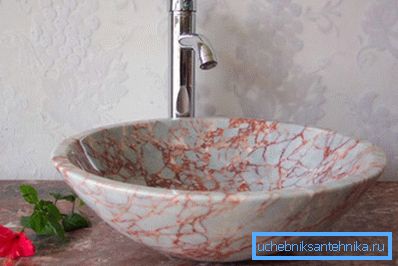
- Such products (composite) are made of granite chips mixed with polymers (acrylic) and the result is an artificial stone that can be given any color (thanks to acrylic) and reproduce the most fantastic patterns on it.
- Products made of artificial stone are very resistant to the effects of detergent abrasives and are not afraid of aggressive chemical environment, it has high impact resistance and heat resistance. When you buy such a bowl, you may encounter such names as silgranit, fragmented, tegranit, porcelain stoneware, and so on, but all these attachments to the word granite will denote the same composite material.
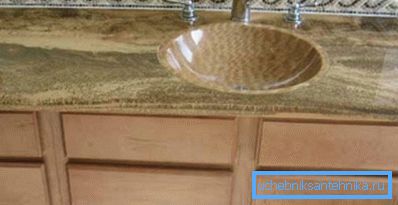
- The most expensive and prestigious material for the manufacture of countertops and sinks, perhaps, can be called marble, but it is very difficult to process and transport because of its fragility, besides, during operation you should beware of sharp blows.
- But the way out was found - it is marble chips with polymers (acrylic) - the same artificial stone, just not granite, but marble, the sample of which you see in the photo above. This is very convenient and beneficial, since the composite material increases impact resistance, facilitates processing and significantly reduces the cost.
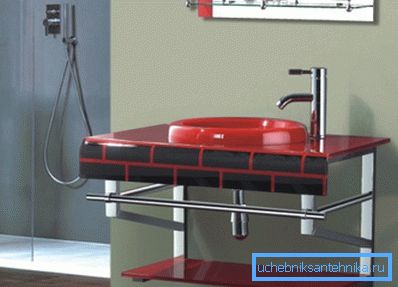
- Now they also produce glass bowls that look very nice in the interior and can be installed on different cabinets, for example, a rectangular or semicircular cupboard under the sink, in fact, will be just a stand and their shape has no technical significance.
- It may seem to you that glass is too unreliable material for such a purpose, but this is not so - thanks to polymeric additives, such bowls are quite shock-resistant, they are not afraid of chemistry, abrasive detergents and hot water.. But because of the impression of fragility that such vessels create, they do not suit every interior and look best in large bathrooms.

- And finally, the cheapest products are steel sinks, which are used more for the kitchen, and will not look at all in the bathroom.. The material itself is quite suitable for its purpose - washing dishes is accompanied by fatty deposits, chemicals, abrasives, objects and hot water - all this is nothing for stainless steel.
Note. Previously, metal shells could be made of black and galvanized steel, but at this time such products are discontinued.
Installation Methods
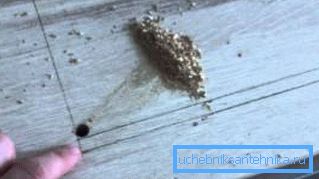
Installation of round, as well as any other sinks can be divided into three main ways - it is invoice, recessed and mortise, although they are very similar to each other, only differ in the complexity of execution (see also the article Enameled sink - a budget solution with excellent characteristics ).
The simplest can be called a waybill and embedded method - here the seat on the tabletop is cut out either under the siphon or under the bowl itself, but in one and the other case the cut is blocked by a shell mass or a side.
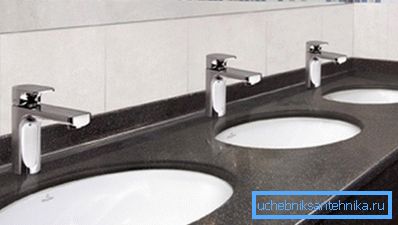
It is much more difficult to install the sinks flush or below the level of the tabletop, as in this case you will also have to cut the hole yourself. The thing is that the face of the cut and its vertical part here remain in sight, therefore, the instruction requires that the edge is clear, and the cut itself is smooth.
Conclusion
You can always install false and mortise shells with your own hands, unless, of course, the tabletop is not of granite or marble. But for mounting the mortise cups, you better invite a specialist with good tools and knowledge of the matter.